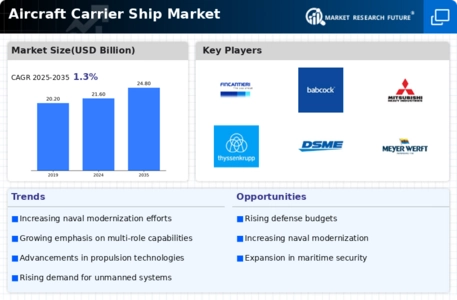Geopolitical Tensions
The Aircraft Carrier Ship Market is significantly influenced by rising geopolitical tensions among nations. As territorial disputes and regional conflicts escalate, countries are compelled to bolster their naval capabilities. The presence of aircraft carriers serves as a deterrent and a means of projecting power in contested waters. Recent developments in various regions have underscored the importance of maintaining a strong naval fleet, leading to increased investments in aircraft carriers. This trend is likely to continue, as nations recognize the strategic advantages offered by these vessels. The Aircraft Carrier Ship Market is poised for growth as countries respond to evolving security challenges and seek to enhance their maritime dominance.
Technological Innovations
Technological advancements play a critical role in shaping the Aircraft Carrier Ship Market. Innovations in propulsion systems, radar technology, and weaponry are enhancing the operational capabilities of aircraft carriers. The integration of advanced systems such as electromagnetic aircraft launch systems (EMALS) and advanced radar systems is becoming increasingly prevalent. These technologies not only improve the efficiency and effectiveness of aircraft carriers but also reduce operational costs. As nations invest in next-generation carriers, the market is likely to witness a shift towards more technologically sophisticated vessels. The demand for carriers equipped with cutting-edge technology is expected to drive growth in the Aircraft Carrier Ship Market, as militaries seek to maintain a competitive edge.
Increasing Defense Budgets
The Aircraft Carrier Ship Market is experiencing a notable surge in defense budgets across various nations. Countries are prioritizing naval capabilities to enhance their military presence and ensure maritime security. For instance, recent reports indicate that defense spending in several regions has increased by approximately 5 to 10% annually. This trend is likely to drive demand for advanced aircraft carriers, which serve as pivotal assets in modern naval warfare. As nations seek to modernize their fleets, investments in aircraft carriers are expected to rise, thereby propelling the Aircraft Carrier Ship Market forward. The emphasis on deterrence and power projection further underscores the necessity for robust naval platforms, making this driver crucial for market growth.
Strategic Partnerships and Alliances
The Aircraft Carrier Ship Market is benefiting from the formation of strategic partnerships and alliances among nations. Collaborative efforts in defense procurement and technology sharing are becoming more common, allowing countries to pool resources and expertise. Joint development programs for aircraft carriers are emerging, enabling nations to share the financial burden and accelerate innovation. Such partnerships not only enhance the capabilities of individual nations but also contribute to the overall growth of the Aircraft Carrier Ship Market. As countries recognize the advantages of collaboration, the market is likely to see an increase in joint ventures and cooperative agreements, further driving demand for advanced naval platforms.
Rising Demand for Naval Power Projection
The Aircraft Carrier Ship Market is witnessing a rising demand for naval power projection capabilities. As nations seek to assert their influence on the global stage, the ability to deploy aircraft carriers becomes increasingly vital. These vessels serve as floating airbases, enabling rapid response to crises and enhancing operational flexibility. The strategic importance of aircraft carriers in power projection is underscored by their role in humanitarian missions, disaster relief, and combat operations. As countries prioritize the development of blue-water navies, the demand for aircraft carriers is expected to grow. This trend is likely to drive investments in the Aircraft Carrier Ship Market, as nations recognize the necessity of maintaining a formidable naval presence.


















Leave a Comment